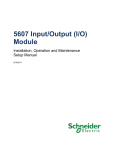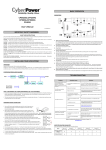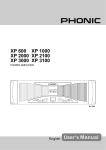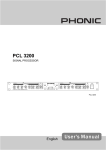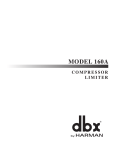Download User`s Manual 323kB
Transcript
Foundation Precision Instrument User’s Manual Version 1.01 www.OOMLLC.com Foundation Precision Instrument User’s Manual rev1.01 PRELIMINARY Table of Contents 1.0 Safety Information...............................................................................................................3 2.0 Introduction ..........................................................................................................................4 2.1 2.2 3.0 Functional Description ........................................................................................................5 3.1 3.2 3.3 3.4 3.5 3.6 3.7 3.8 3.9 3.10 3.11 3.12 4.0 Device Description ................................................................................................4 Installation .............................................................................................................4 Power Connection .................................................................................................5 Signal Connection .................................................................................................5 Phonograph/Line/Balanced/Microphone Pre-amps........................................5 SOURCE Select Switch..........................................................................................5 TRIM Control ..........................................................................................................5 Channel Meter .......................................................................................................5 DIRECT OUT............................................................................................................6 LEVEL Control ........................................................................................................6 CUE and PHONES ..................................................................................................6 X-EQ Summing Crossovers...................................................................................6 MASTER EQ ............................................................................................................6 MASTER/BOOTH/RECORD Outputs ....................................................................6 Available Modifications.......................................................................................................7 4.1 4.2 End-User Modifications.........................................................................................7 Manufacturer Modifications.................................................................................7 5.0 Maintenance and Warranty................................................................................................7 6.0 System Block Diagram........................................................................................................8 7.0 Technical Specifications .....................................................................................................9 8.0 Product Registration Form .................................................................................................9 APPENDIX 1: Differential Phonograph Preamps .......................................................... 10 APPENDIX 2: DIRECT OUT Applications ......................................................................... 10 APPENDIX 3: X-EQ Groups ............................................................................................... 10 Correspondence regarding this document may be sent to [email protected] PRELIMINARY 2 Foundation Precision Instrument User’s Manual rev1.01 PRELIMINARY 1.0 Safety Information Do not remove covers from the unit. No user serviceable parts inside. Refer servicing to qualified personnel only. This equipment must be earthed for safe operation. Do not expose the unit to moisture or rain. CAUTION! RISK OF ELECTRIC SHOCK DO NOT REMOVE COVERS Use only the AC mains cord specified by the manufacturer. Do not disable the protective ground connection for any reason. Thank You for choosing the Foundation Precision Instrument for your application. We are certain that you will be pleased with this device in any application. We would be happy to hear from you concerning your experiences with the Foundation as we continually strive to meet the highest expectations of the people that we design gear for. Order Of Magnitude LLC is a design team dedicated to the creation of high-quality professional audio devices. We rely on engineering that originates in laboratory techniques and have found that great audio is the direct result of good engineering. This manual is written with the intent of helping you get the most out of this device by informing you of some pertinent technical information. The artistic use of the Foundation is entirely up to you. PRELIMINARY 3 Foundation Precision Instrument User’s Manual rev1.01 PRELIMINARY 2.0 Introduction 2.1 Device Description The Foundation Precision Instrument is a six channel analog DJ mixer designed using the highest professional audio specifications. The mixer in a sound system, as the initial source of gain and filtering, has the greatest influence on the final sound quality of the entire system. Unfortunately, it is common for the fidelity of the equipment following the mixer to exceed that of the mixer itself, throwing away thousands of dollars of expected system performance in the process. The Foundation remedies this by providing extremely accurate amplification early in the signal chain that meets or exceeds the performance of almost any devices that might follow it. The Foundation’s straightforward control surface and standard functions make it ideal for live performance mixing while its unusually low distortion and noise make it the ideal tool for the studio environment. Both applications benefit from the reliability, flexibility, and customization afforded by an experienced and thorough design process. The overall layout of the mixer has been heavily influenced by the suggestions of numerous A-List DJ’s from around the world and provides the requested functionality while achieving the specified performance and enclosure size. The main priority of the Foundation design is transparency in the signal path. To this end, the mixer contains the bare minimum of components and no electrolytic capacitors in the signal path. Secondary to this primary goal is giving DJ’s the functions essential to mixing and to allow for expandability. Subtle alterations to the conventional architecture of DJ mixers result in an uncluttered interface with powerful filtering control, while extensive input/output connections allow for the addition of outboard processing. Deceptively simple, it is the streamlined essence of DJ mixing with unprecedented sound quality. In short, there is no equal to the Foundation Precision Instrument in professional dance music mixers. 2.2 Installation Proper installation techniques must be used to ensure that the Foundation meets its high performance specifications. The following are suggestions. The power supply unit (PSU) should be situated as far from the mixer as the supplied cable and situation permits. Avoid routing AC mains cables near signal cables, particularly low-level signal cables such as phonograph signal lines. All audio equipment should have a dedicated mains voltage supply isolated from lighting dimmers, ice-machines, and other electrical noise-producing equipment. Some type of surge protector should be used on all signal processing electronics. If the Foundation is used in a mobile installation, care should be taken to properly support the back of the mixer and power supply chassis. The XLR outputs on the mixer are chassis grounded only, and thus may be used as the ‘shield ground’ in cables with only one end grounded, or in fully grounded systems in which all signal shielding is connected only to earth grounds. High-quality twisted-pair interconnect cable should be used due to its superior shielding and stable capacitance. Heat reduces the long-term reliability of all electronic devices. Since the mixer uses an assortment of high-current devices and LED’s, a certain amount of heat will be internally generated. To minimize the internal temperature of the unit do not mount the mixer near heat-generating equipment of any kind and allow for space surrounding the unit when possible. The ground prong of the power supply’s AC mains cable should not be bypassed or altered in any way as the mixer uses this connection for safety ground. It should be assumed that any device that uses a three-prong AC plug does not have a double-insulated chassis and requires the safety ground to trip a circuit breaker if a short from the enclosure to power develops. Ground loop problems in a sound system should be solved in some other fashion than bypassing the safety ground. PRELIMINARY 4 Foundation Precision Instrument User’s Manual rev1.01 PRELIMINARY 3.0 Functional Description 3.1 Power Connection The Foundation’s external power supply ships from the manufacturer configured for 115V/60 Hz use. This is the standard ‘wall outlet’ voltage available in the United States. Power supplies for other countries are available. After checking to make sure that the power switch on the supply is set to ‘off’ (it will not be lit), connect the multi-pin connector to the rear of the power supply and then to the Foundation, noting that the cable is one-directional. Connecting the multi-pin to the Foundation with power applied risks damaging circuitry in the mixer. The power supply should not be switched on without having the Foundation attached to it. After making this connection, switch the power supply on. Check that all three power supply status LED indicators are lit on the front panel of the mixer. If all three are not lit, turn off the power supply immediately and check that all four fuses on the power supply are intact. If all four fuses are intact, the power supply requires service. No other power supply should be used with the Foundation. The Foundation uses an external power supply for several reasons. Performing the ACto-DC voltage rectification outside of the mixer chassis prevents switching noise from contaminating the signal path. Another advantage is the ability to use two individual power supplies with one as a backup, referred to as a ‘redundant configuration’. Redundant power supplies make catastrophic system shutdown due to power supply failure extremely unlikely. In the event that one power supply fails, the redundant unit immediately senses the failure and seamlessly supplies power to the Foundation. When the mixer is used in high profile situations, such as on-air broadcasts, in which the margin for error is small, redundant power supplies are highly recommended. Redundant supplies should be plugged in to separate AC mains power or an uninterruptible power supply (UPS) to reduce susceptibility to breaker failure. In compliance with many electrical safety codes, the Foundation uses a fully mainsgrounded power connection with the AC ground connected directly to the chassis. Under no circumstance should this ground connection be altered or removed in any way. Improperly designed systems often exhibit interference at 60Hz, sometimes characterized as a ‘ground loop.’ Please note that, although lifting the ground of the Foundation (or other grounded equipment) might alleviate the hum in these systems, it is not the correct way to solve this problem and PRODUCES AN ACUTE SAFETY HAZARD TO THE USER. 3.2 Signal Connection Phonograph and line sources are connected to the Foundation via standard IHF (RCA-type) jacks located on the rear of the unit. A ground terminal screw located near each set of phonograph inputs provides a chassis ground for those tone-arms that require grounding. It is recommended that plugs that fit tightly are used to prevent the connectors from falling out. Microphones are connected through female XLR connectors and are pin two hot. 3.3Phonograph/Line/Balanced/ Microphone Pre-amps The phonograph preamps used in the Foundation are professional-grade microphone pre-amps with RIAA filtering. This circuit is significantly different from conventional phonopre designs through the use of a high gain, low distortion input stage that benefits greatly from the use of balanced interconnect cable between the phonograph and mixer. In the stock configuration, the phonograph input accepts conventionally wired turntables, i.e. unbalanced. Lower noise and an almost unlimited cable length limit can be realized through the factory modification of section 4.2 in the Available Modifications section, which converts the input to fully differential and makes it usable only with modified turntables. Following the input stage is the IEC/RIAA equalization which is provided by actively buffered filter stages. Using separate filter stages allows for a highly precise inverse RIAA curve through minimizing the passive components interaction with each other and for adjusting values individually for accuracy. The two zero-pole pairs are 3180µs and 318µs, and 75µs and 3.18µs. Further technical discussion of the phono pre’s is included in Appendix 1. The line, microphone and balanced inputs follow similar performance specifications. The line input is an extremely high-speed buffering stage with an input impedance of 22kΩ that amplifies consumer-level sources to the +4dBu professional level. The microphone input is designed for standard 150Ω dynamic-type microphones. It is electronically balanced and PRELIMINARY 5 Foundation Precision Instrument User’s Manual rev1.01 PRELIMINARY provides a set 32dB of gain (in addition to the +12dB available at the Trim stage). This is an appropriate range of gain for most hand-held dynamics microphones. There is no provision for phantom power. The balanced line inputs operate at +4dBu and use tip-ring-sleeve connectors with the tip connected to the noninverted input and the ring connected to the inverting input. This input is ideal for situations in which a remote mixer is to be used. Routing the secondary mixer through the Foundation is an easy way to send that mixer to the main system as well as maintain level control. The throughput distortion level of the Foundation is far below almost anything that might be plugged into it and the balanced input assures a minimum of noise from long interconnects. 3.4 SOURCE Select Switch Each channel can source its program from either of its two inputs. This selection is made using the SOURCE switch located above the TRIM control. Channel one can choose between a line and balanced input, channel six has a line and a microphone input, while channels two through five have line and phonograph inputs. The SOURCE switch can also be used as a channel mute switch if one of the two inputs is not being sent signal. 3.5 TRIM Control The TRIM Control follows the SOURCE select switch in the signal path and has a range of +12dB. The TRIM Control is not simply another LEVEL control and should be treated as a true gain stage. Adjusting the signal gain with the TRIM allows the user to set a channel’s program level early in the signal chain and thus achieve maximum use of the mixer’s excellent signal-tonoise ratio. The TRIM control should be adjusted for a peak signal level between 0 and +3 on the channel meters. The red +6 LED warns of impending waveform clipping and should be avoided. Normalizing each channel’s program input level simplifies the task of keeping a constant MASTER output level when mixing sources recorded at different levels. A sound system is designed to operate best when level controls are set to their nominal (unity) point and the TRIM is used to adjust the input to the appropriate level. 3.6 Channel Meter The input level of each channel can be visually monitored using that channel’s LED input meters. This feature can be invaluable for optimizing input levels, troubleshooting sources, and keeping track of what channels are doing what. Meter ballistics follow DIN Specification 45406 PPM response and show only those peaks that are long enough in duration to be audible. 0dB on the input meters corresponds to +4dBu, or about 1.23Vrms. One amber LED indicator shows levels above 0dB that are safe, while two red lamps indicate levels that are in danger of exceeding the voltage range of the circuitry. The top red lamp lights when signal levels reach +12dB which is equivalent to +16dBu. It should be noted that if extreme equalization is taking place in the mixer, some headroom should be allowed at the input stage. If the input stage is adjusted such that the meters are always in the red, and significant gain is being added in the MASTER EQ, there will be signal clipping audible as distortion. The low level -15dBu LED is included to aid in trouble-shooting of interconnect cable or phonograph cartridge malfunction. 3.7 DIRECT OUT Each input channel has a line-level (+4dBu) DIRECT OUT found on the back of the unit. This output derives its signal from just after the TRIM stage and thus is not affected by the channel LEVEL control. The DIRECT OUT adds greatly to the functionality of the mixer in almost any installation. Since this output is basically the output of the preamp of the selected input source, it is ideal for archiving or transferring records to a digital format. The DIRECT OUT may also be used as an auxiliary output for external processing or monitors. A discussion of this feature can be found in Appendix 2. The DIRECT OUT is passively balanced, meaning that if the output is connected to a balanced device using the correct cable it will behave as a balanced output because both the tip and ring of the output jack have equal, nonzero, impedance to ground. This will take advantage of the noise rejecting abilities of balanced gear that may be connected to the DIRECT OUT. The correct cable uses shielded twisted-pair with an IHF (RCA) plug at one end with its tip connected to one of the two inner conductors and the ring connected to the other inner conductor. The shield is not attached at the mixer. At the other end of the cable is a three-circuit connector, such as an XLR or TRS, PRELIMINARY 6 Foundation Precision Instrument User’s Manual rev1.01 PRELIMINARY through which the shield is grounded. In the three-circuit connector, the inner conductor connected to the tip of the IHF jack will be attached to pin 2 (or tip of a ¼” connector) and the other internal conductor is connected to pin 3 (or ring of a ¼” connector). When this output is connected to an unbalanced device with standard RCA cables, it will behave as unbalanced. 3.8 LEVEL Control Each input channel has a LEVEL control on the front panel that is used to adjust that channel’s volume in the MASTER mix. This control’s nominal, or unity, setting is indicated on the front panel with a triangle at numerical indicator seven. The control’s maximum resolution is found around this point and it is generally best to mix with the channel LEVEL controls around this unity position and to use the MASTER as the overall volume setting. Using the nominal point also ensures that maximum signal level is maintained through the internal circuitry of the mixer which is required for the best signal-to-noise ratio. The Foundation uses high-quality conductive plastic rotary pots as level controls due to their superior rotational life, quiet travel and smooth feel. Using rotary faders was initially the standard for all early audio mixers, including those used for broadcast and recording. Their precise and smooth movements are ideal for constantly fading programs completely in and out. The move to linear faders over time was mainly due to mixing applications in which it is more important to be able to see which of many channels are up than to have absolute control over fade in and out response, e.g. live concert sound. The DJ mixing application is based on fully fading every program out while the next one is fully faded in, which is easily done using rotary faders. 3.9 The MASTER mix may also be monitored in the headphone mix via the MASTER CUE control. The MASTER CUE program is derived from before the MASTER level control and is adjustable in level in the headphone mix. This feature is included in the event that there is some disparity between the sound at the mix site and that in the house. Using the MASTER CUE allows the user to closely monitor the actual main mix while cuing an input. The headphone amplifier’s high power capability reduces distortion that causes listener fatigue but can be detrimental to hearing over time. Please use caution with high headphone levels to protect your hearing. 3.10 X-EQ Summing Crossovers The Foundation utilizes two mix groups that physically divide the front panel controls in a classic center console layout. The function of a group is to allow the user to apply processing and level control to several channels at once and the center console layout illustrates the actual grouping of the channels. The groups on the Foundation serve to route the first three channels through X-EQ A and the second three channels to X-EQ B. The X-EQ Summing Crossover divides the program into three sharply-defined frequency bands and gives the user level control over each band before recombining the bands. In essence, the X-EQ allows the user to remove frequency bands from a program in order to selectively mix those bands with a different program. Mixing the vocal region or melody of one track over the low-end rhythm of another is one example. The figure X-EQ CURVE shows the range of the X-EQ bands. CUE and PHONES The Foundation uses a pre-fade listen monitoring system to provide for cueing a program without hearing it in the Master mix. Each input channel has a CUE button located above the channel LEVEL control. Actuating the CUE button on a channel sends a signal derived from after that channel’s TRIM control to the headphone mix. Any number of input channels may be monitored simultaneously in the headphones in this fashion. Using internal jumper settings, each channel may be individually configured to route its output to either of the two X-EQ groups or directly to the MASTER mix. Routing a channel PRELIMINARY 7 Foundation Precision Instrument User’s Manual rev1.01 PRELIMINARY directly to the MASTER will remove the X-EQ, MASTER EQ and any group insert connections from being applied to the channel. This results in less electronics in the signal path which leads to a slight improvement in signal quality. The manufacturer’s configuration has channels one through three routed through Group A, and channels four through six routed through Group B. This configuration is meant to encourage a symmetrical input setup to take advantage of the two mix groups and their XEQ’s. Using channels three and four as the two main phonograph input channels results in each phono input essentially having its own dedicated X-EQ: channel three is automatically routed through X-EQ A and channel four is automatically routed through X-EQ B. Similarly, channels two and five should be used as the line (CD) inputs. Since it would be rare for records and CD’s to be used at the same time, the X-EQ’s can now be used for mixing between the line inputs. Further discussion of this feature can be found in Appendix 3. The two stereo sub-groups are also equipped with TRS insert points located on the rear panel. The group insert points may be used to insert effects devices across a group. The tip of the connector is the send circuit and the ring is the return. The shield of the interconnect cable should be attached to the sleeve of the connector. As these connections are unbalanced, the interconnect length should be kept minimal for low noise interference. 3.11 MASTER EQ The two X-EQ groups are summed previous to the MASTER EQ section. The MASTER EQ is a fixed-point stereo equalizer meant for making tonal corrections to the program. The MASTER EQ has a gain range of +12dB. The LOW EQ is a shelf at 80Hz that increases the low bass region. The MID EQ is a peak-type at 900Hz which corresponds to the vocal region and allows for emphasis or cut of vocals within a track. The HIGH EQ is a shelf at 8kHz that can add brightness to a dull track. The figure MASTER EQ CURVE illustrates the response of the MASTER EQ. The Foundation is designed with a single conventional EQ stage because it has been our observation that, when every channel has EQ, these EQ’s generally become set identically. We interpret this to mean that it is more common to use an equalizer to correct for different stylus responses or changing room acoustics than for adjusting channels relative to each other. It follows that tonal changes can be done on the main mix and not between individual channels. Tonal alteration on individual channels is almost always to remove the low end from one track and mix it over another track, a process that the X-EQ is designed exclusively for. The frequency ranges of the X-EQ and the MASTER EQ are specifically selected to interact with each other to allow almost any curve to be attained. 3.12 MASTER/BOOTH/RECORD Outputs The MASTER EQ stage sends program to both the MASTER level and BOOTH level controls. The MASTER and BOOTH programs are identical and both have balanced XLR outputs on the back panel. The MASTER and BOOTH outputs are electronically balanced circuits capable of driving signals to +27dBu over long line lengths. Unbalanced operation is also possible using the balanced outputs by tying pin three to pin one. This prevents loss of gain and is not harmful to the cross-coupled output circuitry. If the destination is over 3 meters, the balanced configuration should be used. The RECORD output is a split from the MASTER mix after the MASTER level control. The RECORD output may be used for local recording devices (i.e. guest DJ recording devices) or, since the RECORD program is derived after the MASTER Level control, to feed additional zones. The nominal output level at the Record output is -2dBu. Under no circumstance should the RECORD output be used as an auxiliary send to outboard processing that is returned to the mixer. This makes electronic feedback a possibility which results in damage to components in the signal chain and possibly to loudspeakers. 4.0 Available Modifications 4.1 End-User Modifications Channels routed directly to the Main mix buss, bypassing all X-EQ, MASTER EQ and insert functions. PRELIMINARY 8 Foundation Precision Instrument User’s Manual rev1.01 PRELIMINARY 4.2 Factory Modifications Phonograph inputs configured as symmetrically differential. Only phonographs that have been wired with balanced cabling may be used following this modification. RECORD OUT program derived before MASTER level control. Facilitates even recording levels. Phonograph input gain adjusted for moving coil stylus. and loading X-EQ faders upgraded to Penny & Giles™ rail-guide linear faders. 5.0 Maintenance and Warranty The Foundation does not require regular maintenance of any kind save periodic front panel wiping with a damp cloth. All internal active devices are solid state and will generally out-live any of us. Parts that are expected to wear are intentionally specified with industry standard designs. This facilitates replacement in the future. Standards exist for a reason and the design of the Foundation takes advantage of this whenever possible. The Foundation should be powered down when not in use for more than several hours. The practice of leaving solid-state gear powered at all times is detrimental to the reliability of the internal components and is a holdover from the time of vacuum tubes. The only situation that merits leaving solid-state gear permanently powered is if the environment is exceptionally humid, as the internal heat that is generated serves to reduce the amount of moisture in the chassis. Although the Mean Time Between Failure (MTBF) for all internal components of the Foundation would justify a much longer reliability period, this mixer is warranted against defects in workmanship and materials for a period of two years from the date of purchase. This warranty is activated by returning the warranty card included and proof of original purchase. Repair for failures that occur outside of this warranty are made at the manufacturer’s discretion. Repairs made in the field or by unauthorized technicians could void the stated warranty. No other warranty implied or expressed is valid. PRELIMINARY 9 Foundation Precision Instrument User’s Manual rev1.01 PRELIMINARY 6.0 System Block Diagram PRELIMINARY 10 Foundation Precision Instrument User’s Manual rev1.01 PRELIMINARY 7.0 Technical Specifications Inputs Phonograph Impedance Gain Noise Connector Type Line Impedance Connector Type Microphone Gain Noise Connector Type Balanced Gain Connector Type Outputs Direct Outs Group Insert Points Connector Type Master and Booth Out Connector Type Source Impedance Max Signal Level Frequency Response Dynamic Range THD+N Record Out Connector Type Source Impedance Max Signal Level Headphone Out Connector Type Source Impedance Distortion Output Power Equalization X-EQ Master EQ Metering Channel Master Ballistics Power Consumption Environment Physical Dimensions Mixer Chassis Finish Weight Power Supply Weight 47kΩ ||250pF 65dB @ 1 kHz < -90dB ref. 0.776V equiv. IHF Jack (RCA-type) 22kΩ IHF Jack 32dB Fixed < -126dB (ref. 0.776V equiv.) 3-Pin Female XLR (Pin 2=Hot) Unity ¼” TRS Jack (Tip=Pos, Ring=Neg, Sleeve=Ground) IHF Jack (Tip=High, Sleeve=Low) ¼” TRS Jack (Tip=Send, Ring=Return, Sleeve=Ground) 3-Pin Male XLR (Pin 2 Hot) 50Ω +27dBu into 600Ω (minimum load) +0.5dB 20Hz-20 kHz into specified minimum load >110dB 20Hz-20kHz un-weighted <0.02% @ 1 kHz, +18dBm Unbalanced IHF Jack (Tip=Signal, Sleeve=Ground) 100Ω +20dBu into 600Ω (minimum load) ¼” TRS <10Ω < 0.015% @ 1 kHz, ¼ Watt ¼ Watt into 200Ω Load Cascaded Linkwitz/Riley with 24dB/octave slopes Three Bands with Unity to Full-Cut Control range Low/Mid 225Hz, Mid/High 2.25 kHz Fixed-Point Three-Band Semi-Parametric w/+12dB range Low Shelf 80Hz, Mid Peak 900Hz, High Shelf 8kHz -15, -6, -3, 0 Green, +3 Amber, +6, +12 Red [dBv] -15, -12, -9, -6, -3, 0 Green, +3, +6 Amber, +9, +12 Red [dBv] DIN Standard 45406 425VA (213VA)/115V (230V)/60Hz (50Hz)/US (Europe) Operating 0°C to +50°C, Storage -20°C to +60°C 5.25” (133mm) H x 19” (483mm) W, 10” Behind Front Panel Black Anodized 20 lb. 3.5” (90mm) H x 19” (483mm) W, 10” Behind Front Panel 14 lb. PRELIMINARY 11 Foundation Precision Instrument User’s Manual rev1.01 PRELIMINARY 8.0 Product Registration Form Please take a moment to fill out this form and mail it to Order Of Magnitude LLC to notify us that you have purchased a Foundation Precision Instrument. Registering your mixer will allow us to send you updates to the design as well notify you of new products. This is also an opportunity to offer any comments or suggestions as well as ask any questions that you may have regarding the use or design of the mixer. These questions may be used in a FAQ on the OOMLLC.com website. FOUNDATION PRECISION INSTRUMENT PRODUCT REGISTRATION FORM NAME_______________________________________________________________________ ADDRESS____________________________________________________________________ CITY___________________________STATE___________________ZIP__________________ COUNTRY________________________________PHONE______________________________ SERIAL NUMBER______________________________________________________________ DEALER_____________________________________________________________________ PURCHASE PRICE_____________________________________________________________ PURCHASE DATE______________________________________________________________ INTENDED USE________________________________________________________________ EMAIL ADDRESS______________________________________________________________ WEBSITE URL_________________________________________________________________ HOW DID YOU LEARN OF THE FOUNDATION PRECISION INSTRUMENT? _____________________________________________________________________________ _____________________________________________________________________________ _____________________________________________________________________________ _____________________________________________________________________________ PRELIMINARY 12 Foundation Precision Instrument User’s Manual rev1.01 PRELIMINARY Appendix 1: Differential Phonograph Preamps One unique characteristic of the phonograph input stage is its ability to be used as a fully differential input. Differential circuits, have significant advantages over single-ended ones when used with balanced cabling and a balanced source. Any signal sent over any distance is subject to interference noise. Using two conductors having equal impedances to ground (a balanced cable) to carry the signal causes this interference to appear identically on the two conductors. A differential input circuit flips one of these noise signals out-of-phase and sums it with the in-phase noise signal and thus cancels the noise signal to a high degree. Using a differential input is advantageous in high-gain situations, like microphone and phonograph pre-amps, where the circuit has to dig a tiny milli-volt signal up out of the dirt and increase its level by a factor of several hundred. Most turntables do not use balanced cabling, but almost every phonograph cartridge is a balanced source. A cartridge is a balanced source in much the same way that a microphone is. A tiny coil of wire senses the vibrations of the stylus riding through grooves in a record and the output of this coil is through two wires, one carrying the non-inverted signal and one carrying the inverted phase. This means that almost any turntable can be rewired with balanced cable and the Foundation’s differential inputs be taken advantage of. If the cable length from turntables to the mixer is greater than about one meter or the absolute lowest system noise is desired this option is highly recommended. Rewiring a turntable with balanced cable is a relatively simple process. If you are at all uncertain of your ability to perform this procedure, ply a qualified technician with a sixer of micro-brew and have it done correctly. Appendix 2: Direct Out Applications The Direct Outs can be used for many applications. One possible use for the Foundation is as a stand-alone studio recording console for recording vocal tracks or combining acoustic drums with playback music. Use the microphone channel as the microphone input channel. Use the Direct Out of that channel on the rear of the mixer as a send to outboard processing gear (i.e. reverb or compression). Return the processing gear to the mixer via one or more of the remaining line input channels. Using this configuration it is possible to run two turntables, two CD players, and a microphone with a stereo effects return. Another setup allows the artist to use the Direct Outs as effect sends for phonographs or line inputs using much the same signal flow as presented in the vocal performance section. By sending the individual channel Direct Outs to outboard effects processors, entirely new sounds may be created. Reverb, phasing, loop sampling, VCF filters, and surround sound have long been tools of concert sound engineers and can now be used by the professional DJ to their fullest artistic possibilities. Many of these arrangements are simplified by routing all 6 Direct Outs, the Record Out, and one or two Line inputs to a patch bay that is readily accessible by the user. Visiting DJ’s are then able to attach loop samplers, effects devices, and recording devices. Attention must be paid to the use of this setup as it makes it possible to inadvertently send the Master program (via the Record outs) to a channel input. Sending this channel to the Master output would create an electronic feedback loop resulting in uncontrolled ringing at best and system damage at worst. Appendix 3: Groups and X-EQ The X-EQ Summing Crossover differs significantly from conventional equalizers in several ways. Conventional equalizers are ineffective as summing crossovers due to their cut or boost range being relatively limited and the corner frequency points that are most effective in a summing crossover are different from those preferable in a conventional EQ. A frequency point of about 100Hz is well-suited for a conventional low EQ point as increasing these frequencies adds to the impact of a kick or bass track, but this point is too low for a low Summing Crossover point. Removing a bass track or kick drum requires a higher frequency point because these instruments contain significant information in the 100Hz to 250Hz region. Thus the crossover point in the X-EQ between the low-pass filter (LPF) and mid-pass filter (MPF) is 225Hz. A similar situation is found in the higher frequency bands. The crossover point between the mid-pass filter and the high-pass (HPF) filter is 2.25kHz so that a high hat or other high-frequency instrument can be removed in its entirety, while brightening a track with high EQ is best done with a higher frequency point of around 8kHz. PRELIMINARY 13
















